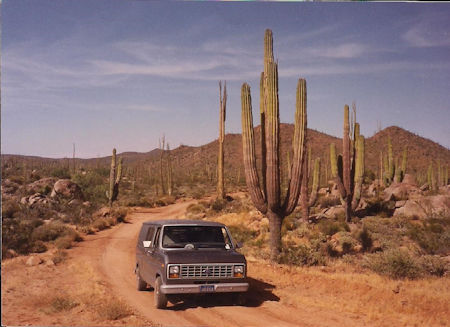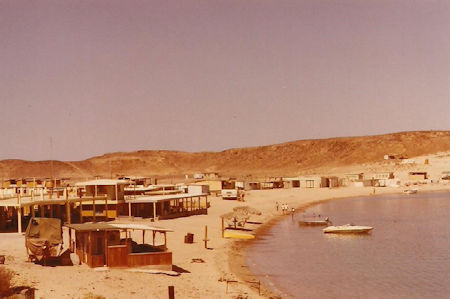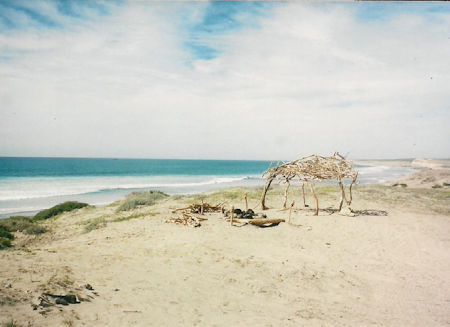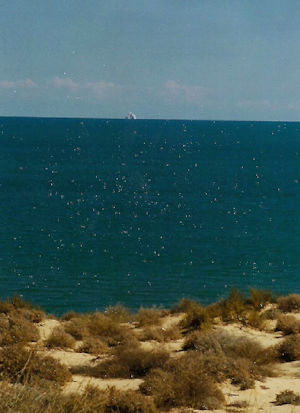 |  |
By Greg Niemann

It was summer of 1983 when Leila and I left San Felipe for a day visit to the community of Puertecitos. Back in the mid-1970s, I had bounced down that 50-mile road to Puertecitos, but my wife had never been.
In our 1982 Ford van, we took the old, inland dirt road that folks used to travel before the coastal road was graded, much less later paved.
The inland road was good and straight, only occasionally dropping through rocky arroyos which slowed our progress as we negotiated amid the boulders.
The road finally entered some barren hills and passed the remains of an old sulfur mine. The hills were splashed with brilliant yellow streaks looking like mounds of dessert. The odor of sulfur jolted us back to reality from our visual fantasy of lemon frosting.
The road joined the coast and the less used coastal route just north of Arroyo Matomi. We passed a few American-style campo developments before descending a hill and entering the cove which protects Puertecitos.
Puertecitos had an American presence with seasonal homes dotting the tree-less hills around the small bay. There was one Pemex station which was closed most of the time, and one modest café where one could rent a sleeping room.
On our day trip we enjoyed walking around town, past the boat ramp and onto the rocks at the point where hot springs bubbled into a natural pool at low tide. The hot springs have been a Puertecitos attraction for years.
Sandier coastal road
Our adventure occurred on the way back to San Felipe. We opted for the slower, sandier coastal road. We figured we’d camp again back in the San Felipe area, and return to our Cantamar casa the next day.
The sparkling blue Sea of Cortez looked inviting that hot and humid August afternoon as we drove north.There were several blufftop areas where homes were being built. Occasionally short roads took off leading right to the blufftop.
We drove down one road where a few rustic thatch palapas overlooked the sea. We stopped, deciding to spend some time cooling off in the tepid gulf water.
The afternoon was one of those “Baja Fever” times that keep Baja aficionados returning to the hemisphere’s longest peninsula. There was no other person in sight and we spent a languorous, carefree time on the beach.

Back at the van we noticed the afternoon was waning and we were about an hour from San Felipe, so we decided to press on. But the soft sand around that inviting palapa served as a seductive web for an unsuspecting 2-wheel drive vehicle.
Within seconds I was dug in so deep that even the back bumper was buried in the sand while the front of the van was high and dry. Our supplies and camping gear, earlier packed so fastidiously, slid down toward the rear door.
We tried to extricate the van to no avail. I started digging under the wheels. I crammed the area’s little availanle brush under the wheels and tried again. Nothing. We just made it worse.
We decided to seek assistance.
I remembered seeing a shack about a half mile back where we turned off the coastal road. We began walking toward it. It was obvious the makeshift tar paper shack was still being used as living quarters, but its occupants were nowhere in sight. There was the usual detritus often found around desert cabins. There were rusting vehicles in varying stages of usefullness; there were piles of parts, junk, and debris. But the people were gone.
We disturbed nothing and walked back to the van.
Darkness was settling in so we prepared to spend the night and seek help in the morning.
A most uncomfortable night
Rather than setting up a campsite, we rearranged gear, moved boxes around, and rolled out the sleeping bag in the van. With our heads at the high end, all night we were sliding down onto the van’s back door.
The incredibly high humidity that accompanies the occasional August monsoon condition kept us both drenched with perspiration all night. Pesky mosquitoes accompanied the dampness in the van and invaded us at will.
The gear kept poking us everywhere, and seemed to worsen with each change of position. Of course, the canter to which our bodies were subjected had us almost standing all night.
I should have set up the tent, but you know what they say about hindsight. I suggested sleeping outside sans tent, but Leila was concerned about snakes and other critters. It seemed like every little sound of the desert was magnified into a threatening beast.
On a couple of occasions headlights bounded down the coastal road. I thought one of those cars might have stopped at the shack.
We awakened early, that is if we ever did sleep. The first hint of light was welcome and soon the rising sun created a warm glow over the blufftop. We decided to check the shack to see if the occupants had returned. They had.
An old man waved us in

As we approached an old man waved us in. He was sitting on a box in his patio, such as it was. The hard-packed dirt area was covered with a rustic palapa made of the skeletons of dried cactus and mesquite trees holding up pieces of cardboard to provide shade in this desolate palm-less setting.
The old man’s well-creased face wore a broad smile which displayed a large gap where a couple of teeth should have been. His well-worn blue jeans were almost brown from the ground-in dirt of the desert. His cowboy hat had holes at the creases.
His appearance and his dwelling shouted poverty, but the continual broad smile and affable hospitality gave us a different message, one of genuine friendliness.
Another man came out of the shack. He was younger but it really was hard to tell how old these desert dwellers were. Just the chores of daily survival were hard on them and aged them quickly. The younger man’s smile and intense interest in our predicament were no less than the older man’s, who we learned was his father-in-law.
The women and children were visiting relatives in Mexicali, and these two went with some friends to San Felipe for the evening.
Before addressing my problem, first we would socialize and talk. That is the way of the rural Bajacalifornio. Working in a large corporation I had to force myself to unwind my anxieties to their pace. I realized the slower lifestyle was one of the big draws of Baja, but my background often fought the change.
“How about some coffee,” the younger man suggested.
The older man found another box and rusty card table chair for us. The kitchen was the bottom half of a 50 gallon drum in the center of the dirt patio. They added twigs to the fire, placed a tin across the opening and set a pan of water upon it to boil. They then produced four cups and a jar of instant coffee.
Our problem was their problem
With our limited Spanish at the time, we still commmunicated. And, our predicament instantly became their predicament.
After coffee, the younger guy went to one of the rusting vehicles, a large pickup with a winch in its bed, but the tires were flat. He started up its engine and to our surprise, it turned over, loud and spewing smoke, but the engine actually worked.
He then planned to pump up the tires and then we would go down and pull the van out of the sand. They found an old manual tire pump among the debris, but the air hose had a hole in it. So now they’re looking for duct tape, to repair the pump, to pump up the tires, to get the pickup running, to go to my van and pull it out of the sand. This succession of events seemed tedious to us, but it is a typical, logical solution in Baja, and if a simple task takes all day, so be it.

But we were saved from the long day. An old Fold pickup bearing their two friends from the previous night pulled up just as I started walking the one-mile round trip to find duct tape. The additional Baja denizens jumped right into the action. We all piled in the back of the pickup and roared off toward our van.
With six people and the pickup pulling, we quickly jerked the van out of the soft sand. Smiles all around. This time I was the host, handing out refreshments.
None of the four would accept any money for doing what their upbringing and culture had ingrained in them. I solved the matter by giving the newcomers the remaining gas out of my five gallon can. That they graciously accepted.
We found a jar of coffee and a few cans of food that our hosts bashfully accepted. I gave them my new roll of duct tape too. They would probably use it to help other silly gringos.
The friendly people of Baja share an empathy and sincere caring that transcends cultural barriers to offer help whenever and whereever needed. No questions asked.
About Greg
Greg Niemann, a long-time Baja writer, is the author of Baja Fever, Baja Legends, Palm Springs Legends, Las Vegas Legends, and Big Brown: The Untold Story of UPS. Visit www.gregniemann.com.